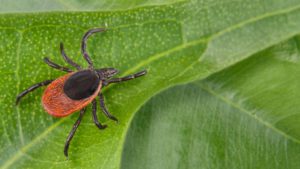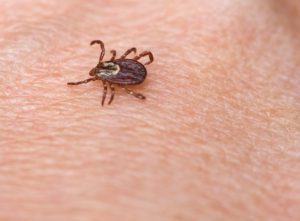MOUSE NESTS IN YOUR YARD ARE HIDING BLACKLEGGED TICKS!
By Chris Williams on October 4, 2019.
New research evidence suggests that when trying to control ticks around your property, it’s even more important than we thought to pay attention to mice nesting on your property at the same time.

Black Legged Tick. Shutterstock.
We know that the blacklegged tick that transmits Lyme disease has several different animal hosts at different stages of its lifecycle. While adult ticks prefer to attach to and feed on white-tailed deer, the immature larval and nymphal stages of the tick seek out smaller mammals, primarily mice. What has never been clear is what happens after the blacklegged immature ticks drink their fill of mouse blood. Typically that is when the tick drops off of its host to undergo a rest period during which it will shed its skin and become a larger nymph, or perhaps even an adult tick.
MICE ARE NOT ALONE IN THOSE COZY NESTS
Since mice spend a lot of time in their nests during the day, you would think a mouse nest would have a pretty good population of digesting and molting ticks just hanging around in the duff. Researchers at the University of Wisconsin-Madison decided to see if that was the case. They tracked radio-collared deer mice and white-footed mice (how they got tiny collars on mice must be another story!) to their nests. They located 28 nests and dissected and collected ticks from 11 of them, a labor-intensive process that took up to 40 hours per nest!

American Dog Tick. Shutterstock.
The tick counters found blacklegged tick larvae (the smallest stage of the tick) in 64% of the mouse nests and American dog tick larvae in 55% of the nests. They found blacklegged tick nymphs in 18% of the nests examined.
The researchers were surprised to discover that a single mouse utilized a number of nests, moving around and using different nests each day. In some cases, the nests were used by other unrelated mice as well. The researchers suggest that nests used by multiple mice on an ongoing basis not only provide a nice overwintering site for the ticks but also provide them with available host animals as soon as they are ready to feed again in spring. This could give the Lyme disease cycle an early seasonal start.
MANAGING MICE AND THEIR NESTS WILL REDUCE DISEASE RISK
What this means for you is that you need to make sure that outdoor mouse control is part of your tick management program for your yard. If you’re treating your yard for ticks and establishing tick-free zones and borders, make sure that you pay attention to any mouse holes/burrows/nests within those zones. Don’t overlook above-ground potential mouse nest sites such as in sheds, inside grills or in abandoned equipment or unused vehicles. But, in fact, eliminating the mice may not be enough, you may need to treat the unoccupied nests to kill ticks inside.
There are many things you can do to make your property less desirable to mice from cleaning up spilled birdseed to eliminating debris and stacked materials around the foundation. Keep in mind that it’s fall and those outdoor mice will be thinking about moving inside as the weather cools. You’ll do yourself a favor if you eliminate them now.
For more on managing mice around your property, see these Colonial blogs: